Theme Parks & Themed Entertainment
Why For haven’t the Imagineers built more rides, shows and attractions around the Disney Villains?
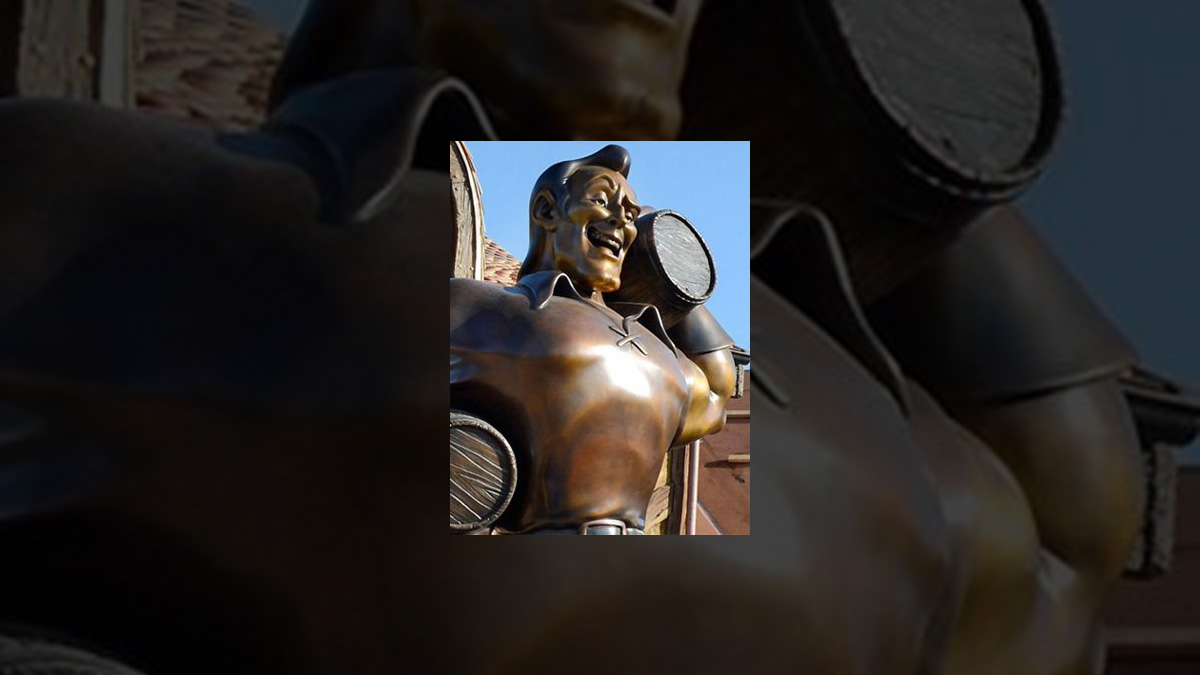
Chris B. wrote in on September 10th to say
Hi Mr. Hill,
Great website and so appreciate how you share your Disney
knowledge.
With the opening of the New Fantasyland Disney has installed
a statue for Beauty and the Beast’s Gaston. Disney villains have typically only
been out and about for the Halloween events. Is Gaston’s statue and tavern the
first Disney Villain to get a permanent statue and “attraction”?
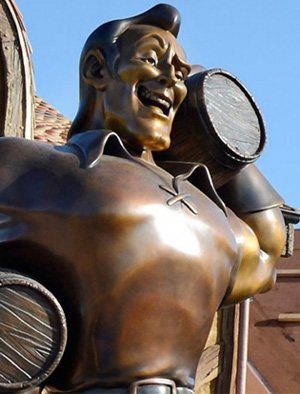
The statue outside of Gaston’s Tavern in the Fantasy-
land expansion area at WDW’s Magic Kingdom.
Copyright Disney Enterprises, Inc.
All rights reserved
Thanks for your kind words. As for Gaston’s Tavern being the
first permanent Disney Villain statue / attraction … Well, that kind of
depends on how you define villain, statue and/or attraction.
After all, Monstro has been swallowing Guests at Disneyland ever
since June 16, 1956. Which is when that theme park’s Canal Boats of the World
ride re-opened with its new Storybook Land overlay.
And those who are fans of early Disneyland concept art will
no doubt recognize the below image. Which shows Monstro as the central
character of his very own theme park attraction. Which drew its inspiration
from the Shoot the Chutes, that early amusement park thrill ride which was
originally introduced back in 1884 at Watchtower Park in Rock Island, IL.
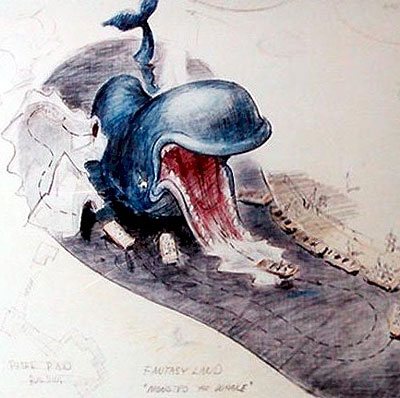
Copyright Disney Enterprises, Inc. All rights reserved
This proposed “Pinocchio” -themed attraction was
to have first taken Guests a series of dioramas which then recreated memorable
moments from that 1940 Walt Disney Productions release. Then — as these
Disneyland visitors had been towed to the top of this ride’s load hill — they
were to have escaped being eaten by that whale by sliding down Monstro’s tongue
into a splashdown area that was supposed to be known as Pinocchio Harbor.
And Monstro wasn’t the only villainous Disney character who
almost made his debut at Disneyland Park’s opening day back in July of ’55.
Check out this cool of piece of concept art for a step-down-into aquarium
attraction (which was part of a suite of water-themed exhibits & rides that
were originally proposed for Fantasyland. Among the other items that never to
Disney’s Anaheim theme park was a Donald Duck Bumper Boats ride and an Old
Mill-themed ferris wheel). Where the only way you made it down below water
level so that you could then see all the fishies was to enter the mouth of the crocodile
from “Peter Pan.”
Unfortunately neither of those two Disney Villain-ish
attractions ever made it off of WED’s drawing board. Mostly because — back in
the late 1950s — Disneyland Park was still trying to recover its initial
construction costs (You have to remember that — until he bought ABC /
Paramount & Western Publishing out in
the early 1960s — Walt was still obliged to split whatever profits his theme
park made with those two companies who had invested in / underwritten the costs
of building this project back in 1954). So money for any additional rides,
shows and attractions was kind of tight back then.
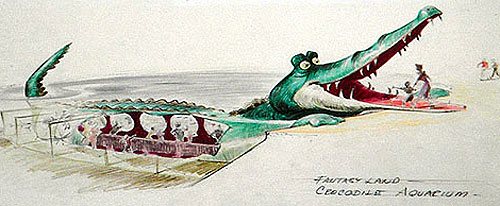
Copyright Disney Enterprises, Inc. All rights reserved
More to the point, it was Frontierland & Tomorrowland
that were perceived as lacking attractions back in the 1950s. Whereas
Fantasyland was seen (by the public, anyway) as a being a hit right out of the
box. Which is why Walt chose to
concentrate whatever free funds he had on expanding those parts of his theme
park. While labeling Fantasyland as something that he’d eventually get around
to fixing (Disney was never entirely happy with the tournament-style show
building that he’d had to build to house the dark rides in this part of his
theme park. Walt always felt that the exteriors of these Fantasyland
attractions made it a little too obvious that Disneyland’s construction budget
could only go so far. Which is why Walt had been forced to abandon his original
concept for Fantasyland. Which was to have this part of the Park be a
picturesque recreation of a European storybook village).
Speaking of which … When it was decided that — on the
heels of adding a second theme park to the Walt Disney World Resort (i.e. EPCOT
Center, which opened in October of 1982) — that Disneyland Park deserved a
little TLC, the Imagineers dusted off Walt’s picturesque-European-storybook-village
idea and decided to redo Fantasyland at that theme park.
Which brings us to what some might argue is the first real Villain
statue in a Disney theme park. That Evil Queen who stands in the window
directly above the entrance to “Snow White’s Scary Adventures.” Every minute or so, a mechanized series of
drapes opens, revealing a statue of Snow White’s nemesis glaring down at all of
the Guests who are queuing up below.

Copyright Disney Enterprises, Inc.
All rights reserved
Interesting side note here: “Snow White’s Scary
Adventures” (to be specific, the revamped version of this attraction which
opened on May 25, 1983 as part of Disneyland’s New Fantasyland) was the first
dark ride whose “Scene One” perhaps did too good a job of setting the
scene for the attraction that follows.
For those of you who haven’t been on Disneyland’s “Snow
White’s Scary Adventures” for a while (or at all), let me refresh your
memory as to how the queue for this attraction is set up. Before you can get to
your ride vehicle, you actually pass by a Reader’s Digest version of the Evil
Queen’s secret laboratory. And as longtime Fantasyland cast members will tell
you, the skull that’s on display on the Evil Queen’s work table has been known
to really frighten small children. Forcing many a parent at that point to turn
around and carry their screaming kid backwards through this queue. Which — on
a busy summer day when the Park is especially crowded — can really make life
difficult for all of the other Guests standing in the “Snow White’s Scary
Adventure” queue.
In an effort to mitigate this situation / let
especially-easy-to-frighten kids know as early as possible that “Snow
White’s Scary Adventures” really is scary, the Imagineers had a very
clever idea. They put a bronze version of the poison apple that the Evil Queen tricked
Snow White into biting right outside the
entrance to the Fantasyland attraction. And given that the people in line just
couldn’t help themselves, they just had to touch that apple … Well, imagine
their surprise when — as soon as they touched that bronze apple — they’d hear
a crash of thunder OR the cackle of the Old Crone (i.e. the form the Evil Queen
took after she drank that potion).
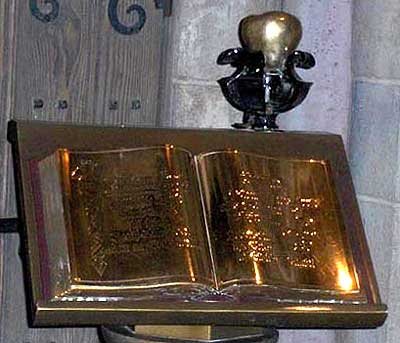
Copyright Disney Enterprises, Inc. All rights reserved
And that crash of thunder / evil laugh is usually enough
(all by itself) to spook skittish children. Who then turn to their parents and
say “I don’t want to go on this ride. It sounds like it’s going to be
scary.” And since these kids are now culled out of the line before they
then encounter the genuinely frightening portion of the queue for “Snow
White’s Scary Adventures” … Well, that then significantly cuts down on
the number of parents who now have to carry panicking toddlers backwards
through the line for this Fantasyland attraction.
And given that this bronze touch-sensitive apple is an
entirely appropriate piece of theming to be found at the entrance to this
attraction … Well, you have to admit that WDI came up with a pretty smart
solution for “Snow White” ‘s perhaps-too-scary queue problem.
Anyway … Getting back to answering your original “Why
For” question now, Chris B. … Once the Walt Disney Company began
recognizing that there was legitimate Guest interest in the Disney Villains as
characters unto themselves, in addition to Disney Consumer Products embracing
this loosely grouped brand / franchise (Witness that Disney Villain Designer
Collection of dolls that the Disney Store began rolling out earlier this month.
The second doll in the series — a high fashion take on the Evil Queen from
“Snow White and the Seven Dwarfs” — hits store shelves on Tuesday),
the Imagineers began toying with the idea of building some Disney
Villains-themed attractions.
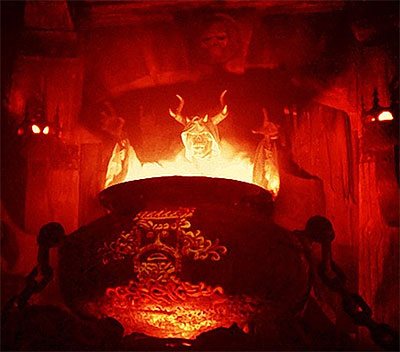
The Horned King AA figure that appeared in the finale of Tokyo
Disneyland’s Cinderella Castle Mystery Tour. Copyright
Disney Enterprises, Inc. All rights reserved
The first such effort — Tokyo Disneyland’s Cinderella
Castle Mystery Tour (which opened in July of 1986) wasn’t considered entirely successful.
Perhaps because WDI chose to build the finale of this walk-thru attraction
around the Horned King, the now all-but-forgotten villain who drove the story
of one of Walt Disney Animation Studios’ less-successful efforts, “The
Black Cauldron.”
And since the Cinderella Castle Mystery Tour (which closed
in April of 2006 to be replaced by a Disney Princess-themed walk-thru
attraction, Cinderella’s Fairy Tale Hall) ‘s
“Let’s-pay-tribute-to-all-sorts-of-Disney-Villains” approach was
thought to be a bit of a bust, the
Imagineers then decided to adopt a less-is-more approach. Designing a single
ride around a specific Disney Villain. Take — for example — that Ursula the
Sea Witch spinner was supposed to added to Paradise Pier as part of the
expansion plan that WDI put together for the original version of Disney’s
California Adventure theme park.
This spinner (which — according to at least one site plan
that I’ve seen for this “Little Mermaid” -themed ride — was supposed
to be built in that open plot of land inside of California Screamin’ near King
Triton’s Carousel. Maybe you know the spot that I’m talking about? It’s off to
the left just before the load / unload area for this coaster?) had a pretty
witty design. Guests were supposed to sit in these flask & bottle-shaped
ride vehicles which were designed to look as though they were being held in the
Sea Witch’s tentacles. And as this oversized version of Ursula began to spin
around, this “Little Mermaid” -themed ride would have — of course —
played a creepy calliope version of “Poor Unfortunate Souls.”
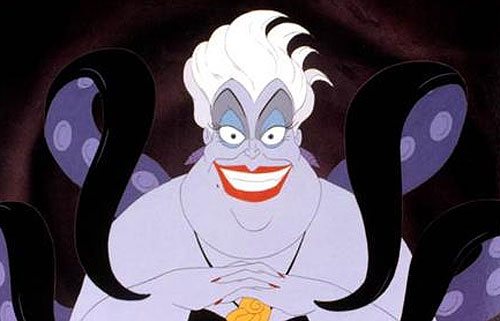
Copyright Disney Enterprises, Inc. All rights reserved
Speaking of California Screamin’ … As the Imagineers were
prepping Version 2.0 of DCA, one of the ideas that was proposed as a way to
bring more Disney characters into this then-troubled theme park was to turn
this coaster into a Disney Villains-themed ride.
The way that WDI was going to do this was actually pretty
clever. What the Imagineers wanted to do was create these enormous iconic props
that would then represent various Disney Villains. You know, Captain Hook’s
hook, Maleficent’s staff, the Evil Queen’s crown? And then these oversized
props would then be placed in and around California Screamin’s ride track. So
that a ride aboard the rethemed version of this DCA coaster would then be seen
as a celebration of all forms of Disney villainy.
I know, I know. The core concept for this California
Screamin’ redo is a bit in the abstract side.
But the argument back at 1401 Flower Street was 1) people scream when they ride roller
coasters AND 2) people scream when they see the Disney Villains in their
various movies. So why not combine these two forms of screaming with a Disney
Villains-themed coaster?
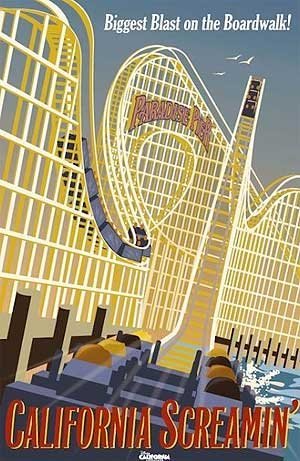
Copyright Disney Enterprises, Inc.
All rights reserved
Mind you, this wasn’t the first time that the Imagineers had
toyed with the idea of an attraction that would incorporate some (if not all)
of the Disney Villains. And — no — I’m not talking about Cinderella Castle
Mystery Tour again. I am referring to one of the greatest ride concepts to
never quite make it off of WDI’s drawing boards, Villain Mountain.
I have this friend who used to work at Imagineering who —
just before he left the Company in the early 2000s — made a point of getting
color copies of all the concept art for Villain Mountain. The various show
scenes that the Imagineers had dreamed up for Villain Mountain. And given the
quality of the art that was churned out for this proposed Walt Disney World
attraction, it’s easy to see why this former Imagineers wanted to make a few
copies before he headed out the door.
But you know what was particularly nifty about this flume
ride (which — at one time, anyway — was envisioned as the replacement for the
Magic Kingdom’s “20,000 Leagues Under the Sea” attraction. Basically
occupying the exact same footprint as that Fantasyland favorite)? That if you
knew how Disney theme park attractions typically operated, this ride was then
going to use that knowledge against you.
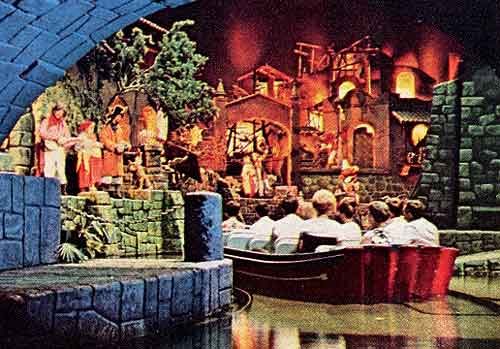
Copyright Disney Enterprises, Inc. All rights reserved
To explain: The ride vehicle that was supposed to be used in
WDW’s “Villain Mountain” was the multi-passenger bateaux which Guests
know from the multiple trips that they’ve already made on “Pirates of the
Caribbean” and “it’s a small world.” Which means that — as
people stepped down into these flat-bottomed boats on “Villain
Mountain” — they immediately had certain expectations. That their bateaux
— as it moved through this show building — would be pushed along through a
trough via a combination of waters jets & belts. More to the point, that
their “Disney Villains” ride vehicle would never, ever leave that
trough.
Which was true. For the first half of this proposed
Fantasyland addition at WDW’s Magic Kingdom. But as your ride vehicle reached
the top of Villain Mountain, you were to enter Maleficent’s lair. And this
unexpected intrusion clearly upsets the Mistress of All Evil. For — with a
wave of her magic staff — Maleficent blasts a gaping hole in the wall directly
opposite where your bateaux is now floating.
And even though you can already see into the very next show
scene that you’re supposed to be floating through while journeying through
Villain Mountain, which lies just beyond where the AA version of Maleficent is
now standing, your boat now breaks out of its nice, safe tough. And as Sleeping
Beauty’s nemesis laugh manically and talks about how she’s now sending all to
Hell, your boat now lurches dangerously toward that gaping hole in the wall as
you’re seemingly sucked into the abyss.
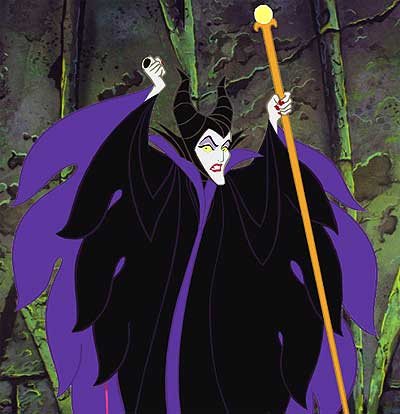
Copyright Disney Enterprises, Inc. All rights reserved
Now at this point, it’s important to remember that
“Villain Mountain” was supposed to be filled with fun tributes to /
cameos by various Disney Villains. So after your boat slipped through that hole
which Ursula supposedly blasted in that wall at this Magical Kingdom show
building … Much in the same way that the logs used in Splash Mountain zoom
through all of those over-sized thorn bushes on their way to the bottom of the
briar patch, your Villain Mountain boat was to have slipped through Ursula’s
giant writhing tentacles.
Then — as you splashed down at the very bottom of Villain
Mountain — for a very brief moment, you were actually supposed to think that
you were in Hell as flames and eerie shadows surrounded you. But then an AA
version of Hades from “Hercules” was supposed to appear. And with
fire extinguisher in hand, he’d have quickly snuffed out all of the flames
before then introducing himself. “Hades, Lord of the Dead. How ya
doin’?” And as your bateaux floated away from this AA figure, Hades was to
have called after you, offering all sorts of tempting treasures if you’d just
agree to sign your soul over to him.
Doesn’t that sound like
a fun ride? Ironically enough, in at least one version of the site plan
that the Imagineers had put together for getting “Villain Mountain”
added to WDW’s Magic Kingdom, this proposed flume-type attraction was to have
been the anchor of an entire Disney Villain Village. Which was to have occupied
much of the same piece of property that the Magic Kingdom’s Fantasyland
expansion is currently being built on.
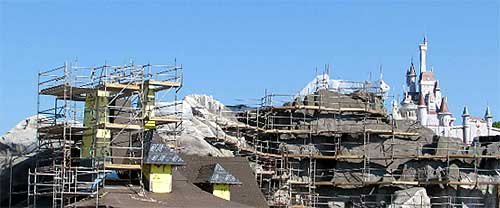
Construction of the Beauty & the Beast portion of the Fantasyland expansion area at
Walt Disney World’s Magic Kingdom
“And what other rides, shops and attractions would this
Disney Villains Village supposedly featured?,” you ask. Well, the way I
heard it, the Ursula spinner was part of the proposed line-up. As was an early,
early version of Gaston’s Tavern. Which — in the end — actually did wind up
getting built at WDW’s Magic Kingdom.
But that’s the way things are at WDI. Ideas that are
originally proposed for one specific theme park project are often resurrected
for an entirely different theme park in slightly mutated form.
Still, it’s kind of interesting to see Gaston’s Tavern
(which was originally pitched to WDW management in the mid-1990s) finally made
it into the Magic Kingdom. Though — that said — one wonders if Disney World’s
Entertainment is still going forward with production of that outdoor stage show
which was once such a big component of the fun that would eventually be
associated with this new Fantasyland venue.
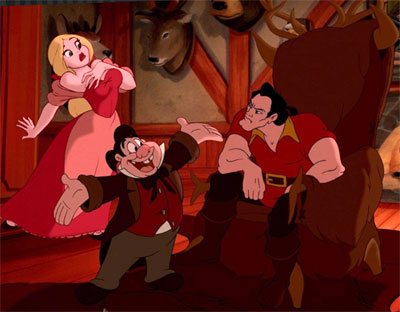
Copyright Disney Enterprises, Inc. All rights reserved
To explain: The original version of Gaston’s that the
Imagineers pitched had this outdoor biergarten. Which — while it wasn’t
immediately obvious — also doubled as a stage.
Anyway … Every day around 4 p.m., WDW’s Operations Team
would begin shooing Guests out of this outdoor biergarten. They’d keep it up
until this open air stage was completely empty and then block this area off to
public access.
And then — right at 5 p.m. — the magic would begin. A
rather depressed looking face character version of Gaston would exit his
Tavern. Nursing a beer, he’d cross over the outdoor biergarten and sit down.
And Gaston would soon be joined by a downbeat face character version of Captain
Hook, sipping from a flute of champagne. And then Hook would be followed by a
somewhat sad-looking face character version of the Evil Queen from “Snow
White.” Who … No one knows what exactly is in the goblet that this
Disney Villain is holding. But it’s bubbling & foaming. And the Evil
Queen is
followed by a morose-looking face character version of Maleficent, who
… Well, you get the idea.
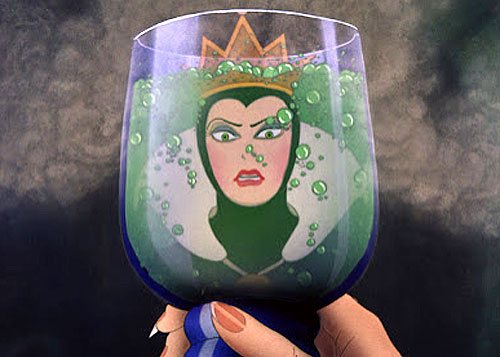
Copyright Disney Enterprises, Inc. All rights reserved
So eventually, this outdoor biergarten / stage is filled
with Disney Villains who are all nursing drinks. You see, they’ve all come to
Gaston’s Tavern for (Wait for it) “Unhappy Hour.” Over the course of
this 10-to-15 minute-long show, we’ll eventually discover that this is a daily
ritual among the villainous characters who live & work in WDW’s Magic
Kingdom. They gather together each day at Gaston’s to grab a quick drink before
heading home. And here — among their evil equals — these Disney Villains
finally have peers that they can commiserate with. I mean, who else in the
world is going to lend a sympathetic ear when you moan about how you almost
defeated Peter Pan, or tricked Snow White into eating a poison apple or
convinced Briar Rose to prick her finger on the spindle of a spinning wheel.
In the original outline for the “Unhappy Hour”
show at Gaston’s Tavern, there was a suggestion that the Disney Villains could
perform a number similar to “Cell Block Tango” in
“Chicago.” Where these characters — in song — would complain about
how frustrating it was to always lose to the hear. To have good continually
triumph over evil.
But then — in a tune that was supposed to have drawn its
inspiration from “Annie” ‘s ever-optimistic anthem,
“Tomorrow,” the Disney Villains was to sing about how maybe tomorrow
will be the day when they finally triumph. And then — with their thirsts
quenched & their hopes renewed — these characters were to have all raised
a glass and toasted villainy.

Copyright Disney Enterprises, Inc. All rights reserved
After that … Well, this being a theme park and all, the
Disney Villains who were taking part in this outdoor show at the biergarten
portion of Gaston’s Tavern were to have made themselves available to the public
(albeit briefly) for photos & autographs before they then ducked backstage.
But doesn’t “Unhappy Hour” sound like a fun idea
for a new outdoor show at WDW’s Magic Kingdom? Mind you, I have no idea if this
is still in the works for the Fantasyland expansion which is supposed to open on December 6th of this
year. Near as I can figure, the current configuration of Gaston’s Tavern
doesn’t have an outdoor biergarten that could double as a stage. But that
doesn’t meant that this performance space couldn’t be added at some point in
the future.
I mean, wouldn’t it be cool if Gaston’s Tavern eventually
become the designated hangout for the Disney Villains? The place at the Magic
Kingdom where — whenever you dropped by there — you’d always find a few evil
characters lurking about?
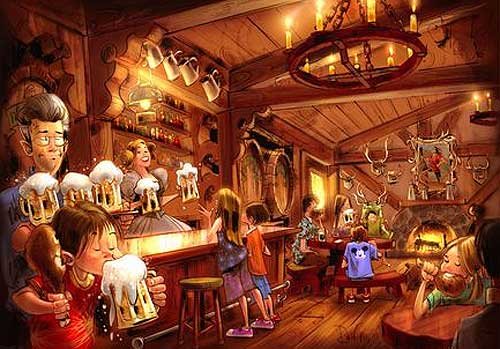
Copyright Disney Enterprises, Inc. All rights reserved
Anyway, Chris B … That’s my epic-length answer to your
rather short Why For question (My apologies for this story taking more than a
few days to finally get posted on JHM. But given that this column is over 3,500 words long and I spent much of last
week traveling, just finding the time necessary to type up this sucker took a
lot of extra effort).
And — with that — I’ve finally delivered those 5 Why For
columns I promised you guys earlier this month. I know, I know. I didn’t get
them all written in a week. But hopefully the stories that I’ve shared here
have made the often-several-days-long wait worth it.
Going forward now: Given the strong response that this
series of columns has gotten from JHM readers as well as from the online
Disneyana fan community, I’m thinking now that Why For will become at least a
twice-a-week feature here on this website.
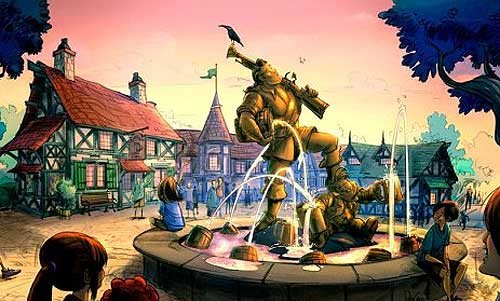
Copyright Disney Enterprises, Inc. All rights reserved
So if you’d like to have one of your Disney-related
questions answered as part of an upcoming Why For column, please send your
queries along to whyfor@jimhillmedia.com and I’ll then see if I can chase down
an answer for you.
Your thoughts?
History
The Super Bowl & Disney: The Untold Story Behind ‘I’m Going to Disneyland!’

One of the highlights of the Super Bowl isn’t just the game itself—it’s the moment when the winning quarterback turns to the camera and exclaims, “I’m going to Disney World!” This now-iconic phrase has been a staple of post-game celebrations for decades. But where did this tradition begin? Surprisingly, it didn’t originate in a stadium but at a dinner table in 1987, in a conversation involving Michael Eisner, George Lucas, and aviation pioneers Dick Rutan and Jeana Yeager.

The Unlikely Beginning of a Marketing Sensation
To understand the origins of this campaign, we have to go back to December 1986, when the Rutan Voyager became the first aircraft to fly around the world without stopping or refueling. Pilots Dick Rutan and Jeana Yeager completed the nine-day journey on December 23, 1986, flying over 26,000 miles before landing at Edwards Air Force Base. Their historic achievement earned them national recognition, and just days later, President Ronald Reagan awarded them the Presidential Citizen Medal at the White House.
Meanwhile, Disney was gearing up for the grand opening of Star Tours at Disneyland, set for January 12, 1987. Following its usual playbook of associating major theme park attractions with real-world pioneers, Disney’s PR team invited astronauts Gordon Cooper and Deke Slayton to the launch event. But in a twist, they also invited Rutan and Yeager, who were still making headlines.

A Dinner Conversation That Changed Advertising Forever
After the Star Tours opening ceremony, a private dinner was held with Disney CEO Michael Eisner, George Lucas, and Eisner’s wife, Jane. During the meal, Eisner asked Rutan and Yeager, “You just made history. You traveled non-stop around the planet on a plane without ever refueling. How are you ever going to top that, career-wise? What are you two gonna do next?”
Without hesitation, Jeana Yeager replied, “Well, after being cramped inside that tiny plane for nine days, I’m just glad to be anywhere else. And even though you folks were nice enough to fly us here, invite us to your party… Well, as soon as we finish eating, I’m gonna go over to the Park and ride some rides. I’m going to Disneyland.”
Jane Eisner immediately recognized the power of Yeager’s statement. On the car ride home, she turned to Michael and said, “That’s a great slogan. I think you should use that to promote the theme parks.” Like many husbands, Michael initially dismissed the idea, but Jane persisted. Eventually, Eisner relented and pitched it to his team.
The Super Bowl Connection
With Super Bowl XXI just around the corner, Disney’s PR team saw an opportunity. The game was set for January 25, 1987, at the Rose Bowl in Pasadena—just miles from Disney Studios. What if they convinced the winning quarterback to say, “I’m going to Disneyland” live on-air?
Disney quickly struck a deal with both quarterbacks—Phil Simms of the New York Giants and John Elway of the Denver Broncos—offering each $75,000 to deliver the line if their team won. Simms led the Giants to victory, making history as the first athlete to say, “I’m going to Disney World!” on national television.
A Marketing Triumph
That year’s Super Bowl had the second-highest viewership in television history, with 87 million people watching Simms say the famous line. The next day, Disney turned the clip into a national commercial, cementing the phrase as a marketing goldmine.
Since then, “I’m going to Disneyland” (or Disney World, depending on the commercial) has been a staple of championship celebrations, spanning the NFL, NBA, and even the Olympics. What started as a casual remark at dinner became one of the most successful advertising campaigns in history.
A Lasting Legacy
Jane Eisner’s keen instinct and Disney’s ability to act quickly on a great idea created a tradition that continues to captivate audiences. The “I’m going to Disneyland” campaign remains a testament to the power of spontaneous inspiration and smart marketing, proving that sometimes, the best ideas come from the most unexpected places.
To learn more about Disney’s ties to the world of sports, check out I Want That Too: A Disney History and Consumer Product Podcast.
Television & Shows
How the Creators of South Park Tricked A-List Celebrities to Roast Universal – “Your Studio & You”
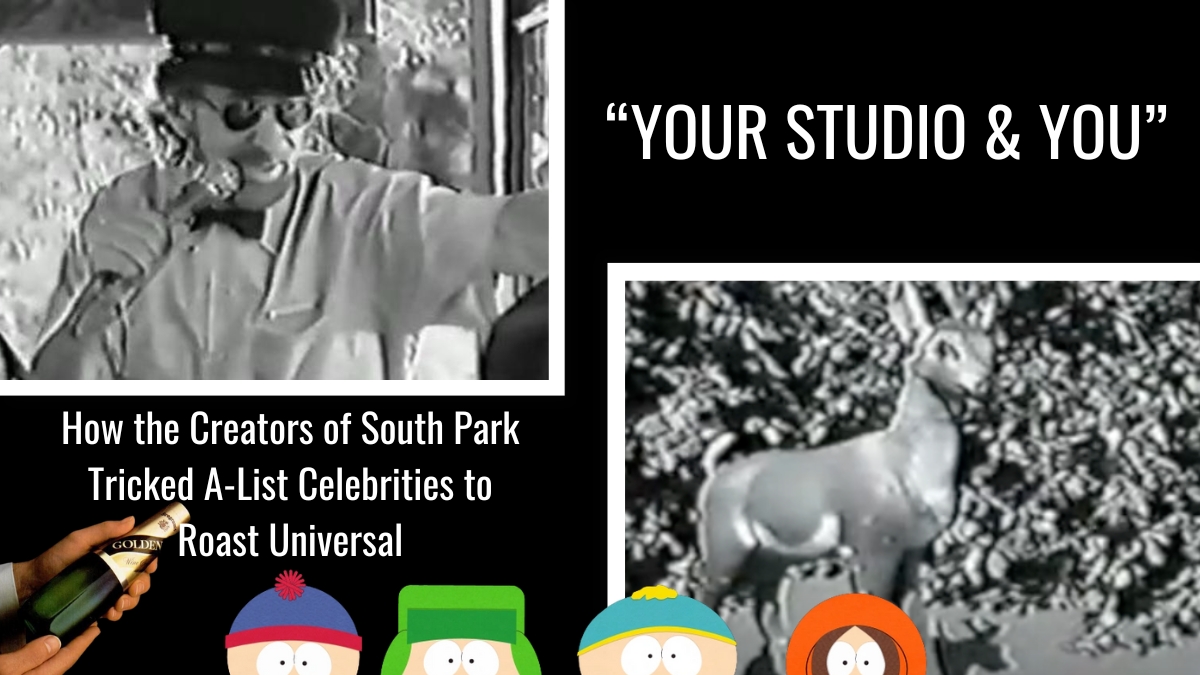
Universal Studios has a rich and storied history, but few moments are as peculiar—and as hilariously cutting—as the creation of Your Studio & You. This 14-minute parody film, commissioned in 1995 to celebrate Universal’s new ownership under Seagram’s, brings together an all-star cast, biting humor, and the unmistakable comedic fingerprints of Matt Stone and Trey Parker.
Long before South Park debuted on Comedy Central in 1997, Stone and Parker were already carving out a reputation for their irreverent style, and Your Studio & You perfectly encapsulates their knack for turning even the most corporate project into something delightfully subversive.
Matt Stone & Trey Parker Before South Park
Stone & Parker were already known out in Hollywood as funny guys. Thanks largely to “The Spirit of Christmas,” which was this video greeting card that they’d crafted for a Fox executive – who then distributed this infamously funny thing (which had Our Lord Jesus Christ & Santa Claus literally duking it out for the holiday affections of Cartman, Kenny, Stan & Kyle) to friends & family.
This was the early 1990s. No internet. Each copy of “The Spirit of Christmas” was made on VHS tape and then mailed. Went viral the old-fashioned way. It’s rumored that George Clooney made over 300 copies of “The Spirit of Christmas” and passed these VHS taps along to friends and family.
Things didn’t move as fast as they do today. “The Spirit of Christmas” still became a sensation out West.
Zucker Brothers
Matt & Trey also had other supporters in the entertainment industry. Among them David Zucker, who was one of the members of ZAZ (i.e., Zucker Abrahams Zucker), the talented trio that made “Airplane!” in 1980, “Top Secret!” in 1984 and the three “Naked Gun” movies.
- The original “Naked Gun” in 1988
- “Naked Gun 2 & 1/2 : The Smell of Fear” in 1991
- and “Naked Gun 33 & a 1/3: The Final Insult” in 1994
All five of these parody films had been made for Paramount Pictures. But in the Late Winter / Early Spring of 1995, Universal had persuaded the Zucker Brothers to come over and set up shop in a bungalow on their lower lot. With the hope that – at some point further on down the line – David & his brother Jerry would start making funny films for Universal.
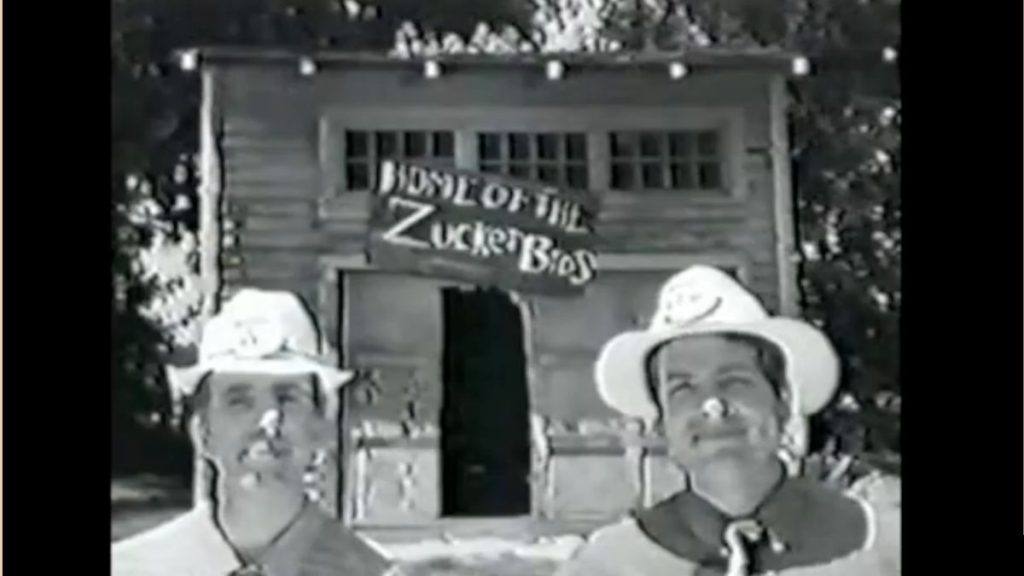
And it’s during this same window of time (We’re now talking April of 1995) that news breaks that Seagrams (Yep, the adult beverage company. Who – at the time – was making an absolute fortune on the sales of wine coolers) was about to buy a majority stake in MCAUniversal. We’re talking control of 80% of that company’s stock. Which would effectively make Seagrams the new owners of Universal Studios.
Edgar Bronfman
And Edgar Bronfman – the owner of Seagrams – knew that Universal had had a tough time with its previous owners – which had been the Matsushita Electric Industrial Co. of Japan. Matsushita had bought MCA back in November of 1990 for $7.5 billion but had never really understood the entertainment industry.
This is why – after repeatedly butting heads with Lew Wasserman & Sidney Sheinberg (i.e., the heads of Universal Studios & the Universal theme park respectively) when it came to creative control of this company – Matsushita decided to wash it hands of the entire enterprise. Agreeing to sell their holdings in MCA to Seagrams for $5.7 billion (effectively taking a nearly $2 billion loss on this investment).
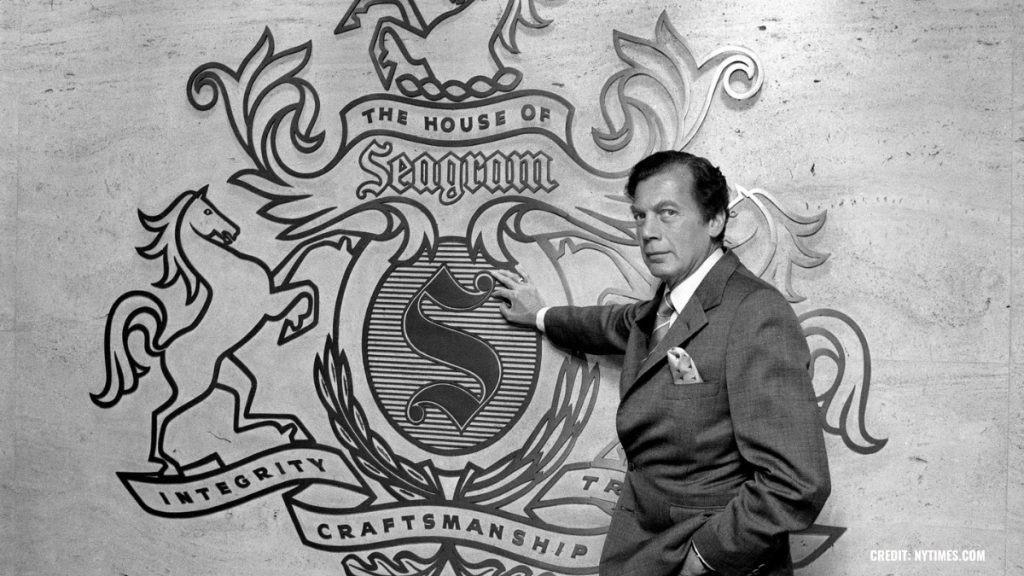
And Bronfman … He knew that some bad feeling had developed between Hollywood’s creative community and the Japanese owners of Universal. The thinking was that executives at Matsushita Electric had just not gotten what it took to make movies & TV shows.
And Edgar? Right from the get-go, he wanted to show that Seagrams was NOT going to be Matsushita Electric Redux. Bronfman was looking for a way to send a clear message to Hollywood’s creative community that Universal’s new owners got it. That they were willing to work with Hollywood to make the best possible movies & TV shows at Universal.
And how did Edgar decide to get this message across? By making a funny movie.
Zucker Commissions Trey Parker for “Your Studio & You”
Mind you, Bronfman himself didn’t make this film. The owner of Seagrams reached out to David Zucker. Who – after initially agreeing to produce this introduction-to-Universal film – then farmed out the production of the actual project to Trey Parker. Who – just two days before shooting was supposed to star on the Universal Lot – persuaded Matt Stone to come help him on this project.
Which brings us to “Your Studio and You.” Which is a parody of an educational film from the 1950s, right down to being shot in black & white and featuring a very generic soundtrack.
Now what’s amazing about watching “Your Studio and You” today is that this 14-minute-long film features some of the biggest names working in Hollywood back in the mid-1990s. We’re talking about people like recent Golden Globe winner Demi Moore, Sylvester Stallone, Michael J. Fox and Angela Lansbury. Not to mention two of the most powerful men in all of Hollywood, Steven Spielberg & Jeffrey Katzenberg.
And what’s especially interesting about watch “Your Studio and You” is that – as you watch these performers go through their paces in this motion pictures (which – most of the time – involves doing some innocuous task while holding a Seagram’s wine cooler) – you often get the feeling that this star is not in on the gag.
So how did Matt & Trey get away with this? Simple. There was never actually a script for “Your Studio and You.”
Filming “Your Studio & You” at Universal Studios Hollywood
Mind you, David Zucker would always insist that there was. Especially when he’d phone up celebrities on the Universal Lot and say “Hey, I’m sending over a couple of college kids later today. They’re working with me on a new parody film. It’s something that we’re doing for the new owners of Universal. I need just a half hour of your time. We’re shooting something special for the party we’ll be holding when the Seagrams people first arrive at the Studio. Absolutely. You’ll definitely get an invite to that party. So can I count on you to help these kids out? Beautiful. They’ll be over there later this morning.”
And then Matt & Trey would show up and say “… Dang, Miss Lansbury. We’re sorry. We must have left our copy of the ‘Your Studio and You’ script back in our office. Which is clear on the other side of the Lot. So – rather than waste your time – why don’t we do this instead? Follow us over to the Psycho House. Where we’re then going to get footage of you painting the front porch on Mother Bates’ house while you say ‘Gosh, with all of the wonderful improvements going on around here, everyone is going to want to work at Universal.’ Oh, and can we also get you to wear this button on the front of your blazer which reads ‘Universal is A-OK’ ? “

And over & over again, the biggest names who were working for Universal at that time took part in the production of “Your Studio & You” because A) David Zucker vouched for Matt Stone & Trey Parker and B) this was something that was being made for the new owners of Universal. And it’s just natural to want to get in good with the new boss.
Steven Spielberg, Jeffery Katzenberg, and Jaws
But no one at Universal anticipated that “Your Studio & You” would wind up being as sharp edged as the finished product turned out to be. I mean, it’s one thing to bite the hand that feeds you. But “Your Studio & You” ? It doesn’t just bite the hand. It takes the hand off at the wrist.
It’s a brutally funny film. With one of the meanest moments reserved for Steven Spielberg, who plays a driver on the Universal Studio Tour who’s trying to persuade a tram full of bored tourists (one of whom is played by Jeffery Katzenberg) that the “Shark Attack” scene down by Jaws Lagoon is actually exciting.
Spielberg actually says lines like “ … Whoa, whoa. What is going on here? Ladies and gentlemen, this never happens. Look out! It’s a shark! Whoa, that is one big scary shark.”

Mind you, as footage of this mechanical shark repeatedly coming up out of the water is shown, “Your Studio & You” ‘s off-screen narrator (who is voiced by Trey Parker says):
“But what about tomorrow? If we don’t keep in step with the times, things that were once neat and thrilling can become old and stupid.”
“Your Studio & You” Reception
This film was supposed to be shown only once at the welcoming party for Seagrams executive on the Universal Lot. And I’m told that – when Edgar Bronfman saw the finished product at that party – he reportedly turned to David Zucker and said “ … That’s a little more mean-spirited that I think it needed to be.”
And with that, “Your Studio & You” was supposed to go back into the Universal vault, never to be seen again. But when “South Park” debuted on Comedy Central in August of 1997 and then became a sensation for its biting humor, there was suddenly a lot of interest in what else Matt & Trey had done. Which is why copies of “The Spirit of Christmas” began to circulate. And – over time – copies of “Your Studio & You” began to bubble up.
Which – as Stone & Parker have repeatedly pointed out – was just not supposed to happen. Largely because none of the celebrities who appeared in “Your Studio & You” had never signed releases for Universal’s legal department. Because – again – this was for a movie that was only going to be shown once at a private function on the Universal Lot.
Matt mentioned (as part of a career retrospective at the Paley Center in LA back in 2000) that “ … they wouldn’t even let us keep a copy of the finished film.”
It’s a funny but brutal movie. And worth taking a look at today especially if you’re a theme park history buff because it shows Universal Studios Hollywood’s “Jurassic Park: The Ride” still under construction on the Lower Lot. That attraction would finally open to the public in June of 1996.
“Your Studio & You” became a lot easier to see after Seagrams sold off its share of Universal to Vivendi in 2000. Copies began propagating online after that. Though Universal Legal will periodically make an effort to get the latest copy of “Your Studio & You” taken off the Internet because – again – none of the performers who appear on camera ever signed the proper releases and/or were paid for their efforts.
That said, if you’re up for a mean-spirited laugh, “Your Studio & You” is well worth 14 minutes of your time. That said, once you watch this thing, be warned:
- You’re immediately going to be thirsty for a Seagram’s wine cooler
- And you’re going to have a sudden desire to go out & buy a porcelain deer.
Theme Parks & Themed Entertainment
Disney and Macy’s 90-Year Thanksgiving Day Parade Partnership: From Mickey’s First Balloon to Minnie’s Big Debut
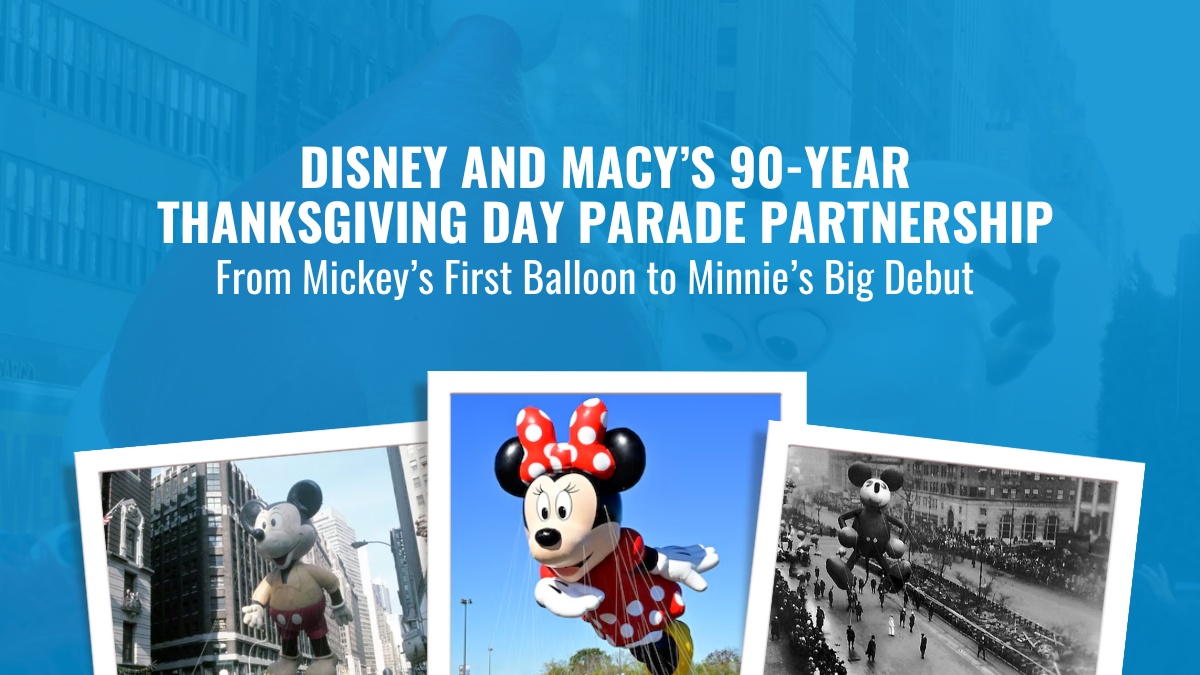
Now, folks, if you’re like me, Thanksgiving just wouldn’t be the same without a coffee, a cozy seat, and Macy’s Thanksgiving Day Parade on the TV. And if you’re really like me, you’re watching for one thing: Disney balloons floating down 34th Street. Ever wondered how Mickey, Donald, and soon Minnie Mouse found their way into this beloved New York tradition? Well, grab your popcorn because we’re diving into nearly 90 years of Disney’s partnership with Macy’s.
The Very First Parade and the Early Days of Balloons
The Macy’s Thanksgiving Day Parade goes way back to 1924, but if you can believe it, balloons weren’t part of the festivities until 1927. That first lineup included Felix the Cat, a dragon, and a toy soldier, all towering above the crowds. Back then, Macy’s had a pretty wild idea to end the parade: they would let the balloons drift off into the sky, free as birds. But this wasn’t just Macy’s feeling generous. Each balloon had a message attached, offering a $100 reward (about $1,800 in today’s dollars) for anyone who returned it to the flagship store on 34th Street.
And here’s where it gets interesting. This tradition carried on for a few years, right up until 1932, when Felix the Cat almost took down a plane flying over New York City! Imagine that—you’re flying into LaGuardia, and suddenly, there’s a 60-foot balloon drifting toward your wing. Needless to say, that was the end of Macy’s “fly away” stunt, and from then on, the balloons have stayed firmly grounded after the parade ends.

1934: Mickey Mouse Floats In, and Disney Joins the Parade
It was 1934 when Mickey Mouse finally made his grand debut in the Macy’s parade. Rumor has it Walt Disney himself collaborated with Macy’s on the design, and by today’s standards, that first Mickey balloon was a bit of a rough cut. This early Mickey had a hotdog-shaped body, and those oversized ears gave him a slightly lopsided look. But no one seemed to mind. Mickey was there, larger than life, floating down the streets of New York, and the crowd loved him.
Mickey wasn’t alone that year. He was joined by Pluto, Horace Horsecollar, and even the Big Bad Wolf and Practical Pig from The Three Little Pigs, making it a full Disney lineup for the first time. Back then, Disney wasn’t yet the entertainment powerhouse we know today, so for Walt, getting these characters in the parade meant making a deal. Macy’s required its star logo to be featured on each Disney balloon—a small concession that set the stage for Disney’s long-standing presence in the parade.
Duck Joins and Towers Over Mickey
A year later, in 1935, Macy’s introduced Donald Duck to the lineup, and here’s where things got interesting. Mickey may have been the first Disney character to float through the parade, but Donald made a huge splash—literally. His balloon was an enormous 60 feet tall and 65 feet long, towering over Mickey’s 40-foot frame. Donald quickly became a fan favorite, appearing in the lineup for several years before being retired.
Fast-forward a few decades, and Donald was back for a special appearance in 1984 to celebrate his 50th birthday. Macy’s dug the balloon out of storage, re-inflated it, and sent Donald down 34th Street once again, bringing a bit of nostalgia to the holiday crowd.
A Somber Parade in 2001
Now, one of my most memorable trips to the parade was in 2001, just weeks after the 9/11 attacks. Nancy and I, along with our friends, headed down to New York, and the mood was something I’ll never forget. We watched the start of the parade from Central Park West, but before that, we went to the Museum of Natural History the night before to see the balloons being inflated. They were covered in massive cargo nets, with sandbags holding them down. It’s surreal to see these enormous balloons anchored down before they’re set free.
That year, security was intense, with police lining the streets, and then-Mayor Rudy Giuliani rode on the Big Apple float to roaring applause. People cheered his name, waving and shouting as he passed. It felt like the entire city had turned out to show their resilience. Even amidst all the heightened security and tension, seeing those balloons—brought a bit of joy back to the city.

Balloon Prep: From New Jersey’s MetLife Stadium to California’s D23 Expo
Each year before the parade, Macy’s holds a rehearsal event known as Balloon Fest at MetLife Stadium in New Jersey. This is where handlers get their first crack at guiding the balloons, practicing with their parade masters, and learning the ropes—literally. It’s an entire production unto itself, with dozens of people rehearsing to make sure these enormous inflatables glide smoothly down the streets of New York on parade day.
In 2015, Macy’s took the balloon show on the road, bringing their Buzz Lightyear balloon out to California for the D23 Expo. I was lucky enough to be there, and watching Buzz get inflated piece by piece in the Anaheim Convention Center parking lot was something to behold. Each section was filled with helium in stages, and when they got around to Buzz’s lower half, well, there were more than a few gas-related jokes from the crowd.
These balloons seem to have a personality all their own, and seeing one like Buzz come to life up close—even outside of New York—had all the excitement and anticipation of the real deal.

Mickey’s Comeback as a Bandleader and Sailor Mickey
After a long hiatus, Mickey Mouse made his return to the Macy’s parade in 2000, this time sporting a new bandleader outfit. Nine years later, in 2009, Sailor Mickey joined the lineup, promoting Disney Cruise Line with a nautical twist. Over the past two decades, Disney has continued to enchant parade-goers with characters like Buzz Lightyear in 2008 and Olaf from Frozen in 2017. These balloons keep Disney’s iconic characters front and center, drawing in both longtime fans and new viewers.
But ever wonder what happens to the balloons after they reach the end of 34th Street? They don’t just disappear. Each balloon is carefully deflated, rolled up like a massive piece of laundry, and packed into storage bins. From there, they’re carted back through the Lincoln Tunnel to Macy’s Parade Studio in New Jersey, where they await their next flight.

Macy’s Disney Celebration at Hollywood Studios
In 1992, Macy’s took the spirit of the parade down to Disney-MGM Studios in Orlando. After that year’s parade, several balloons—including Santa Goofy, Kermit the Frog, and Betty Boop—were transported to Hollywood Studios, re-inflated, and anchored along New York Street as part of a holiday display. Visitors could walk through this “Macy’s New York Christmas” setup and see the balloons up close, right in the middle of the park. While this display only ran for one season, it paved the way for the Osborne Family Spectacle of Dancing Lights, which became a holiday staple at the park for years to come.

Minnie Mouse’s Long-Awaited Debut in 2024
This year, Minnie Mouse will finally join the parade, making her long-overdue debut. Macy’s is rolling out the red carpet for Minnie’s arrival with special pop-up shops across the country, where fans can find exclusive Minnie ears, blown-glass ornaments, T-shirts, and more to celebrate her first appearance in the Thanksgiving Day Parade.

For those lucky enough to catch the parade this year, you’ll see Minnie take her first float down 34th Street, decked out in her iconic red bow and polka-dot dress. Macy’s and Disney are also unveiling a new Disney Cruise Line float honoring all eight ships, including the latest, the Disney Treasure.
As always, I’ll be watching from my favorite chair, coffee in hand, as Minnie makes her grand entrance. The 98th annual Macy’s Thanksgiving Day Parade airs live on NBC, and it’s a tradition you won’t want to miss—whether you’re on 34th Street or tuning in from home.
-
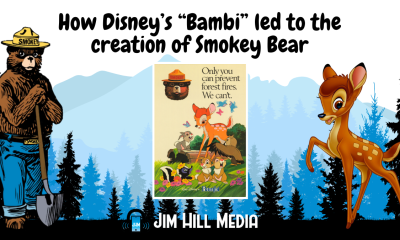
 Film & Movies12 months ago
Film & Movies12 months agoHow Disney’s “Bambi” led to the creation of Smokey Bear
-

 Theme Parks & Themed Entertainment7 months ago
Theme Parks & Themed Entertainment7 months agoDisney’s Forgotten Halloween Event: The Original Little Monsters on Main Street
-

 Theme Parks & Themed Entertainment7 months ago
Theme Parks & Themed Entertainment7 months agoThe Story of Mickey’s Not-So-Scary Halloween Party: From One Night to a Halloween Family Tradition
-

 Film & Movies7 months ago
Film & Movies7 months agoHow “An American Tail” Led to Disney’s “Hocus Pocus”
-

 Theme Parks & Themed Entertainment5 months ago
Theme Parks & Themed Entertainment5 months agoDisney and Macy’s 90-Year Thanksgiving Day Parade Partnership: From Mickey’s First Balloon to Minnie’s Big Debut
-

 Television & Shows3 months ago
Television & Shows3 months agoHow the Creators of South Park Tricked A-List Celebrities to Roast Universal – “Your Studio & You”
-

 History2 months ago
History2 months agoThe Super Bowl & Disney: The Untold Story Behind ‘I’m Going to Disneyland!’
-

 Podcast1 week ago
Podcast1 week agoEpic Universal Podcast – Aztec Dancers, Mariachis, Tequila, and Ceremonial Sacrifices?! (Ep. 45)






